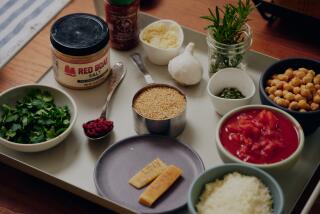Cultivating Chives Can Add Flavor to Flower Beds, Food
- Share via
Chives have onion or garlic flavor, and their leaves contribute flavor to soups, salads, entrees and, especially, eggs.
The edible flowers, according to an article in the current issue of Country Living, when added to salads and cream cheese, contribute a touch of color, crunchy texture and a hint of onion flavor.
Allium schoenoprasum, sometimes known as onion chives for the mild onion flavor they possess, are the more common variety, with leaves that grow 12 to 18 inches high. Globe-shaped lavender flower heads form in late spring.
The other chive variety, called garlic chives, Chinese leaks or Oriental garlic (C. tuberosum), tastes mildly like garlic.
With large, flat, grasslike leaves, garlic chives have flower heads that open in summer to reveal white, star-shaped flowers. Cultivated for centuries in China and India, this variety is widely grown in tropical Asia and commercially in Southern California.
The green leaves of garlic chives are used for seasoning, as are those of common chives. If the leaves are covered by soil during cultivation, they turn yellow or blanch. Considered a delicacy by Chinese cooks, blanched chives are often stir-fried in vegetarian dishes, tossed with noodles, added to soups or mixed with meat in dumplings.
Onion chive blossoms bottled in white-wine vinegar turn it into a pale-lavender infusion. The flowers become fibrous as they grow old, so select young blossoms for culinary use.
You can cultivate your own chives, as they are easy to propagate and grow. They need at least six hours of sun a day in average soil. Chives can be started from seed or by transplants.
If sowing seeds, sprinkle over moist, well-drained soil and cover lightly with more soil. Seedlings will take several years to establish themselves firmly.
Fertilize chives with fish emulsion in the spring or if leaves appear yellow.
Once the chives are established, you can harvest them throughout the summer and into fall by cutting the leaves or flowers an inch above the ground. A sharp knife is preferred, because scissors crush the leaves as you cut.


